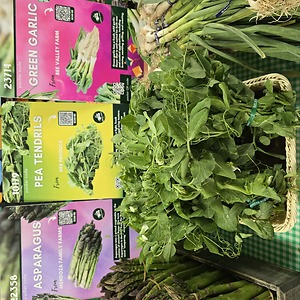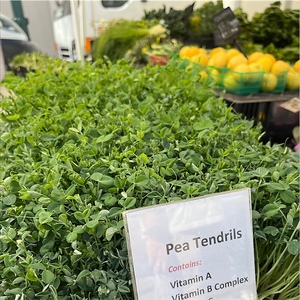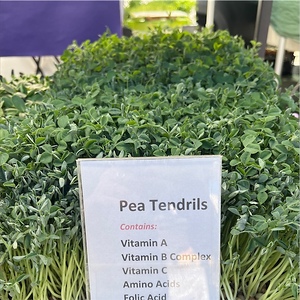


Pea Vines
Estimated Inventory, 10 lbs : 5.10
This item was last sold on : 07/16/25
Description/Taste
Pea tendrils are comprised of shoots with developing leaves or a combination of longer stems bearing slender vines, flowers, and leaves. The tendril's appearance will vary depending on its stage of maturity when harvested, but the developing vines are generally gathered young, retaining a mild flavor and texture. The immature vines have round and hollow, green stems with thin, coiled pale green tendrils. There are also succulent leaves attached to the vines, often considered the most tender part of the plant, that are soft and display a light green hue. In addition to the leaves and stems, some Pea tendrils may display white, pink, or purple blossoms, which are also edible and share a subtle, grassy flavoring. Pea tendrils emit a light, fresh aroma and have a crisp, slightly crunchy consistency. The vines also contain green and nutty flavors mixed with a mild sweetness and a faintly bitter minerality giving the tendrils a refreshing and vegetal quality.
Seasons/Availability
Pea tendrils are available in the early spring. Depending on the climate, they may also be sown and harvested again in the fall.
Current Facts
Pea tendrils, botanically classified as Pisum sativum, are the new shoots of a pea vine belonging to the Fabaceae family. The curling, slender, and delicate vines typically form at the beginning of the pea plant’s life cycle and are harvested before the pods develop to maintain a tender texture. Pea tendrils are also known as Pea vines and Pea shoots and can be gathered from the ends of the vines of sugar snap, snow pea, and some shelling bean varieties. The young vines are highly favored for their refreshing green flavor, crisp texture, and unique appearance and are considered a rarity of spring as the tendrils only remain in season for a couple of weeks each year. Pea tendrils are not a new culinary ingredient, having been a staple vegetable in Chinese cuisine for thousands of years, but in the New World, the tendrils did not become popular until they were used as an edible garnish in high-end restaurants in the late 20th century. In the modern-day, Pea tendrils are still viewed as a fresh and rare springtime ingredient, but they are also increasing in availability through the addition of fall plantings for use in gourmet culinary applications.
Nutritional Value
Pea tendrils share many of the same vitamins and minerals that are found in the pods and peas. The tender shoots are an excellent source of fiber to stimulate the digestive tract and contain antioxidants to protect cells against free radical damage. The tendrils also provide vitamin C to strengthen the immune system, vitamin A to maintain healthy organ functioning, folate to develop red blood cells, and contain minerals such as zinc, potassium, calcium, and manganese.
Applications
Pea tendrils have a subtle, vegetal flavor showcased when served raw or lightly cooked in steamed, stir-fried, or sauteed preparations. It is recommended to only use fresh, young tendrils as more mature versions may contain bitter flavors and a fibrous consistency. Pea tendrils are a favorite ingredient to add texture to salads. If the white flowers are still attached to the tendril, they can also be incorporated into salads with light vinaigrettes to enhance but not overpower the fresh flavor. Pea tendrils can also be tossed into soups and pasta, blended into pesto as a basil substitute, or layered into sandwiches for added crunch. The neutral, grassy flavor of the tendrils can be used as an edible garnish or fresh topping over tacos and spring rolls. In addition to fresh preparations, Pea tendrils can be lightly stir-fried or sauteed and prepared similarly to spinach. Pea tendrils pair well with other spring vegetables, including radishes, spring onions, mushrooms, asparagus, and fava beans, aromatics such as ginger, shallots, and garlic, honey, almonds, water chestnuts, bamboo shoots, potatoes, avocados, arugula, spinach, sesame, citrus, strawberries, and herbs such as mint, basil, and dill. Pea tendrils should be used within 1 to 2 days of purchase for the best quality and flavor. The shoots will also last up to one week when stored unwashed, wrapped in a paper towel, and kept in an open plastic bag in the refrigerator.
Ethnic/Cultural Info
Pea tendrils have become a favored ingredient sustainably harvested from home gardens throughout the United States during the coronavirus pandemic. In 2020, temporary nationwide food shortages and stay-at-home orders led to a resurgence in American families creating customized home gardens. Experts liken the trend of pandemic gardens to the victory gardens developed during World War II, and families are gardening to promote relaxation, produce a steady supply of healthy produce, and regain a sense of control during chaotic times. Pandemic gardens have also evolved into a sector of the zero-waste movement. Gardeners are learning how to use all parts of the plant, and pea plants have become a popular crop for their versatility and edible nature. Pea tendrils are purposely harvested from the plants at the beginning of the plant’s life cycle, promoting thicker growth for later developing plump pods, and the tendrils are incorporated into home recipes for added nutrients and flavor. Pea plants have also become valued in pandemic gardens for their easy-to-grow nature, high yields, and low impact on the surrounding environment.
Geography/History
Peas are considered one of the oldest cultivated crops and are descendants of wild varieties native to Western Asia, North Africa, and the Eastern Mediterranean. The plants have been growing wild for thousands of years and were quickly spread across Asia and Europe through trade routes, arriving in China sometime during the 1st century BCE. Over time, new cultivars of peas were created from the wild varieties, developing many of the pea cultivars commonly grown in gardens in the present-day. In the 15th century, peas were introduced to the New World through explorers and were extensively planted throughout North America. Though green peas have been cultivated worldwide for centuries, utilizing the plants for their young tendrils was not often practiced. Pea tendrils were traditionally incorporated into Asian cuisine, and eventually, the use of the tender greens permeated other cuisines throughout Europe and the United States in the late 20th century. Today Pea tendrils are utilized in culinary applications worldwide, and the fresh shoots are found seasonally through farmer’s markets, Asian markets, specialty grocers, and home gardens.
Featured Restaurants
Restaurants currently purchasing this product as an ingredient for their menu.
| The Lion Share | San Diego CA | 619-564-6924 |
| La Jolla Country Club | San Diego CA | 858-454-9601 |
| Bar Ella | San Diego CA | 858-808-2286 |
| La Costa Resort & Spa Main Kitchen | Carlsbad CA | 760-930-7063 |
| Cove House | La Jolla CA | 858-999-0034 |
| Tartine | Coronado CA | 619-435-4323 |
| Town & Country Main Storeroom | San Diego CA | 619-291-7131 |
| Secret Sister | San Diego CA | 619-281-0718 |
| US Grant Hotel Grill | San Diego CA | 619-232-3121 |
| Waverly | Cardiff CA | 619-244-0416 |
| The Lion Share 2025 | San Diego CA | 619-564-6924 |
| The Plot | Oceanside CA | 422-266-8200 |
| The Pearl Hotel | San Diego CA | 877-732-7573 |
| Stake Chophouse & Bar | Coronado CA | 619-522-0077 |
| Merenda | Oceanside CA | 703-459-4145 |
| Bridges at Rancho Santa Fe | Rancho Santa Fe CA | 858-759-6063 |
| Bernardo Heights Country Club | San Diego CA | 858-487-4022 |
| Sheraton Carlsbad (20/20) | Carlsbad CA | 760-827-2400 |
| Convention Center Shell | San Diego CA | 619-954-3063 |
| South O Brewing Catering | Oceanside CA | 925-381-5392 |
Recipe Ideas
Recipes that include Pea Vines. One

















